|
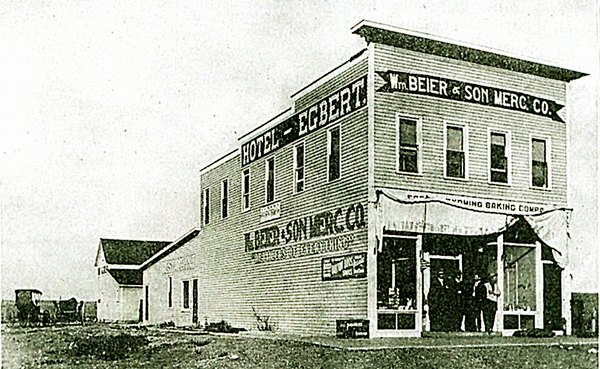
Egbert, Wyoming, 1908.
Eleven miles to the west of Pine Bluffs the early traveller came to Egbert named after Augustus A. Egbert (1835-1895) who joined the railroad in 1867 as a conductor. He worked his way
up to a railroad superintendent. His brother, Daniel W. Egbert (1834-1923) also worked for the
railroad and ultimately served as a yard master in Iowa. . The 1916 guide to the
Lincoln Highway indicated that there was a hotel, garage and telephone. The hotel was constructed in 1908. American Legion
Post No. 21 was chartered in 1921. The charter was cancelled in 1948.
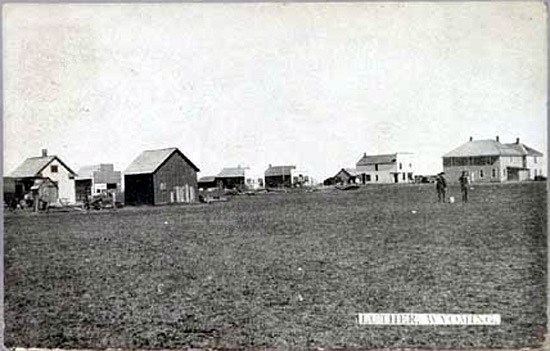
Burns, Wyoming, 1908 (See text below).
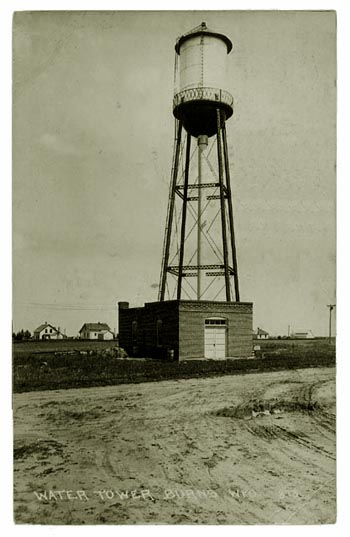 Burns, Wyo. water tank, approx. 1915.
Burns, Wyo. water tank, approx. 1915.
Approximately five miles to the west of Pine Bluffs was the rail siding of
Tracy also named after DeWitt Tracy. And further to the west, as indicated
by the above map, the Lincoln Highway originally proceeded
through the towns of Egbert, Burns, and Hillsdale, all of which were originally established by the
railroad as rail sidings. On those sidings, before the days of block signals, a train would await the passage of
higher priority train. At the beginning of the railroad, trains were managed by a system of
time schedules and orders. The orders indicated what trains were on the line, the respective priorities, and where trains
were to be sidetracked awaiting the passage of higher priority trains were relayed by telegraph, written down on
light paper knowns as "flimsies," and conveyed to the conductor of the train. The conductor was the officer of the
train, the "master of the ship" so to speak.
It then became necessary that each such siding have a clear distinctive
identity. Therefore, all sidings were named. Around some small towns would develop. Those towns would take on the
name of the siding. Such are Egbert, Burns, and Hillsdale, each having assumed the name of a siding. Others, such as
Tracy remain even today as mere sidings. On back roads paralleling railroad tracks, one may observe sidings on which there may be a
sign giving a name. It is not necessarily the name of a long-gone defunct town, but, instead, the name of the
siding.
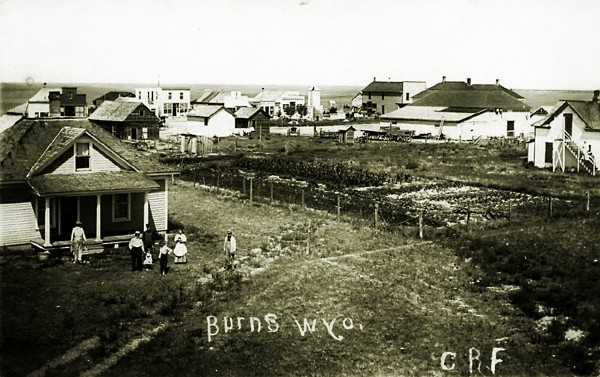
Burns, Wyoming, 1909.
Burns, Wyoming, was also an early railroad siding until 1907. In that year, some German Lutherans established a
town next to the siding. The Lutherans attempted to name the newly formed town after Martin Luther. Burns was the center
of the Golden Prairie District promoted by the J. Ross Carpenter's Federal Land & Securities Co. formed in 1905.
By 1908, Burns had a newspaper, The Golden Prairie Herald. It later changed its name to the
Burns Herald.
Carpenter (1867-1943) sold land
using leases with options to buy. Carpenter, Wyoming, south of Burns, is named for him. With the
end of the "Dry Farming" boom, Federal Land & Securities Co. was out of business by 1922. Nevertheless, farming of grain remained important to the area.
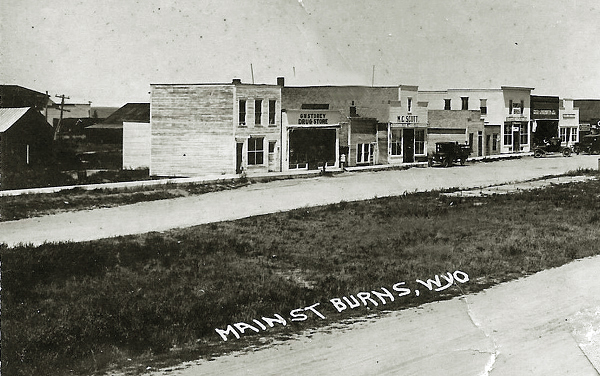
Burns, Wyoming, c, 1909.
By 1910,
the area gained enough population to warrant a post office. The same year, the Union Pacific constructed a depot. The depot, similar to
many stations along the line, was a prefabricated structure, with waiting room, office, freight room, and quarters for the
agent.
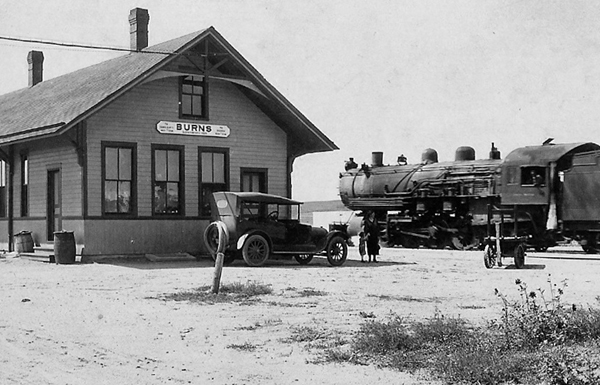
Burns Depot c, 1915.
The question of the name of the town again arose.
The railroad in its dispatches over the years had continued to use the name "Burns." Thus, the older name which had been in use by the railroad since
its construction, was used for the
post office, the name having come available for postal use when a post office of the same name
in present day Sublette County closed. By 1920, Burns had achieved a population of about 300 and had
two banks, the Burns State Bank and the Farmers State Bank organized in 1919.
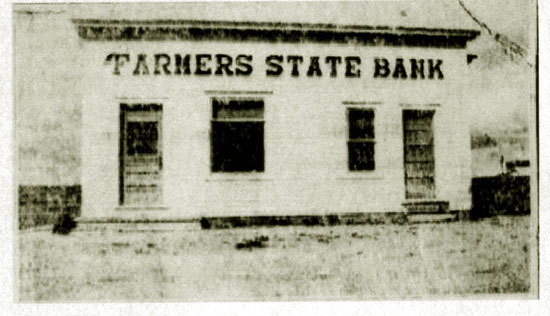
Farmers State Bank, 1920
Burns was apparently named by the railroad after J. J. Burns an
early railroad telegrapher. Burns worked his way from telegrapher to operator, assistant store keeper and ultimately to
purchasing agent for the Union Pacific.
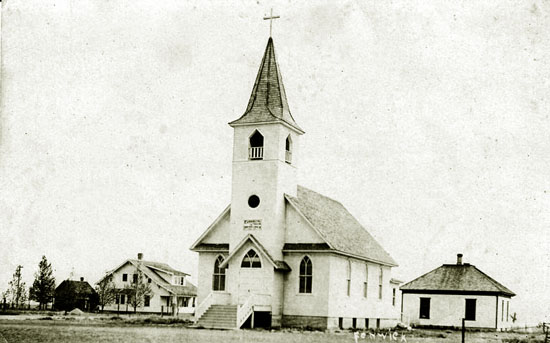
Luthern Church, Burns, Wyoming, undated.
Besides providing for transcontinental travel, the Lincoln Highway reduced the necessity for reliance on
the railroad for local trafic. Trips to and from Cheyenne were no longer arduous.
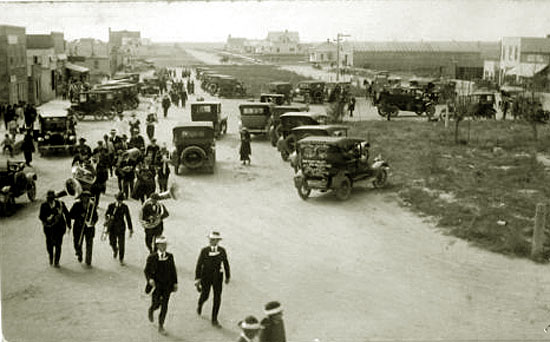
Cheyenne Chamber of Commerce promotion, Burns,
Wyoming, October 7, 1920.
About 200 members of the Cheyenne Industrial Club (the Chamber of Commerce) participated in a promotional
tour of eastern Laramie County, including Hillsdale to the north of Burns, Pine Bluffs, and Carpenter.
The band in the photo is the Burns Town Band which travelled to Hillsdale and accompanied the
Chamber of Commerce members back to Burns. An aeroplane travelling overhead led the procession. After
distributing advertising material to the various businesses in Burns, the group again led by the
aeroplane proceeded on to
Pine Bluffs.
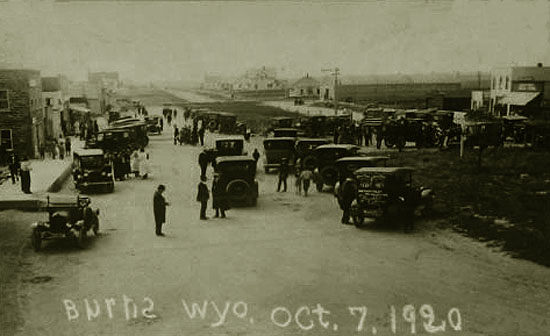
Cheyenne Chamber of Commerce promotion, Burns,
Wyoming, October 7, 1920.
The motorcar with the sign on the back is a factory-sponsored air-cooled Franklin.
In Pine Bluffs, Representative Frank Mondell gave a speech at the Pastime Theatre, dinner was provided by the
Ladies Aid Society at the Opera House, and some of those that were Masons sat in while degree work was
performed. The group then proceeded on to Carpenter and Grover, Colorado.
Music this page: Lincoln Highway as arranged and sequenced for brass band. Courtesy Horse Creek Cowboy Band
Next Page, Lincoln Highway, Hillsdale.
|